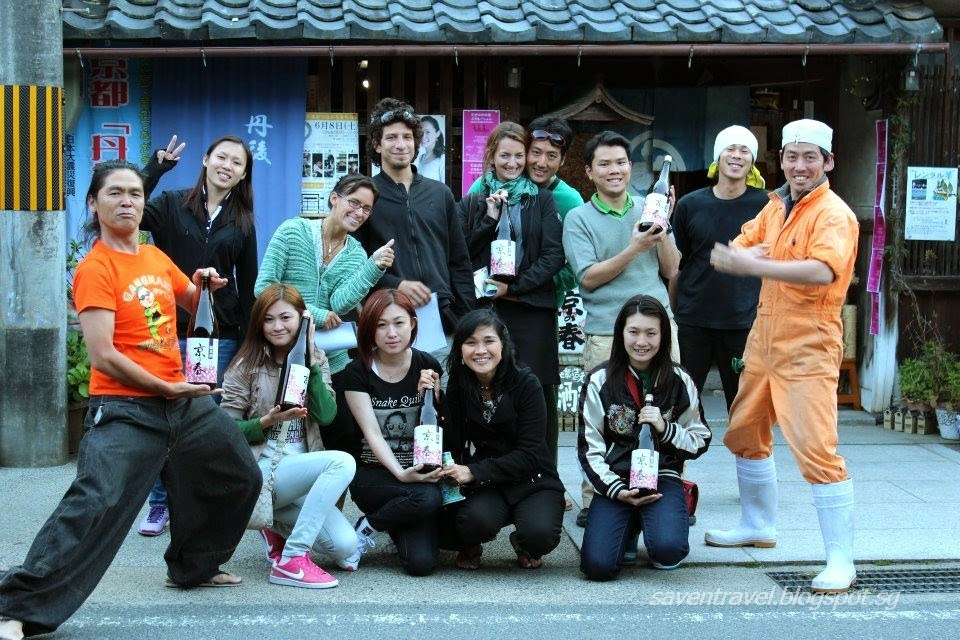7-May-2013:
We had a long road trip (almost 6 hours) from Osaka to Amanohashidate a town in Kyoto prefecture. Arriving in a beach house at Ine Town, we were welcomed by Kentaro-san He showed us his fish caught that day, which he sliced it into Sashimi, for our dinner.
Kentaro-san is the husband of the owner of a Mukai Sake Brewer Co., Ltd. in Ine Town, we visited his Sake factory the next day.
Since the rest house was unoccupied, he allowed us to stay here. The house is facing the sea, hence at night it was extremely cold, and we cant even swim in the freezing cold water that day.
8-May-2013:
The next day, we explored the beautiful sites of Amanohashidate.
Amanohashidate (天橋立) is a pine covered sandbar that spans the mouth of Miyazu Bay in the scenic, coastal region of northern Kyoto Prefecture. Viewed from the mountains at either end of the bay, the Amanohashidate Sandbar (which roughly translates to "bridge in heaven") looks like a pathway between heaven and earth. The scene has been admired for centuries and is ranked among Japan's three most scenic views.
Amanohashidate, sometimes called "The Bridge to Heaven" is a 3.6 kilometer sand bridge formed over thousands of years and is now a beloved landmark in northern Kyoto prefecture on the coast of the Sea of Japan.
It's been crowned one of the three most beautiful spots in Japan. To behold the natural beauty best, we recommend you rise to a peak on either side by lift or cable car.
Traveling across the nature park's land bridge is a journey you will not forget with the carefully attended pine forest and fine sand beaches. If you'd prefer a sea-side view, there are ferries and charter boats to show you the sights from the ocean.
Several other attractions can be explored on foot or by rental bicycle at either end of the sandbar.
Lovely scenery,

Summarizing the attractions we have visited in Amanohashidate :
Amanohashidate View Land
It is the observatory stands on the top of Mt. Monju and you can see spectacular Amanohashidate there. We took a chair lift (6min) to the observatory (Monorail or chair lift /Adult: 850 yen Child: 450 yen)
Amanohashidate Sandbar

The canonical way to view Amanohashidate is to turn your back to it, then bend over and look at it upside down from between your legs —

This is supposed to make the bridge appear as if it floats to heaven, and bring good luck.

Revolving Bridge
This unusual bridge turns 90 degrees when ships go out the waterway and it connects Amanohashidate and Monju area.
This boat passes by once the bridge has fully rotated 90 degrees.
The bridge that was built in 1923 was turned by hand, but the present electric one was rebuilt in May 1960 because many ships comes in and out of the waterway.
Shinto Shrine
After crossing bridge, we saw the Motoise Kono Shrine (元伊勢籠神社, Motoise Kono Jinja), it is located near the northern end of the Amanohashidate Sandbar.
Historically the most important shrine of the Tango Region in northern Kyoto Prefecture, it once enshrined Shinto's most venerated deity, the Sun Goddess (Amaterasu); and Toyoukehime, a local deity of clothing, food and housing.
Sake Brewery
Later that afternoon, we pass by the Sake Brewery of Kentaro.
Having a long history since 1754, their company hangs "Sugi-tama" (a ball made of cedar branches, the natural color change of which, signifies the ideal brewing period for the sake) in front of the building as a symbol of their sake brewing skill.
Aside from wines, they also sell sake flavored cake, I really enjoyed tasting it, that I bought it together with the wine.

Facade of the residence of Kentaro, there is this prominent tree which according to him has been there for hundreds of years as a sign of good fortune.
The Mukai brewery has an incredibly long history having been founded in 1754 and is still a family run business today.

The current Tōji [Master Brewer] is Kuniko who is the eldest daughter of the Kuramoto [Brewery Owner] Yoshihisa Mukai. Kuniko became one of the first women Tōji in Japan when she became a professional Sake brewer after she graduated from agricultural university. Kuniko’s husband - Kentaro has now also joined the brewing team at Mukai after having worked at Akishika Shuzō.
Across the road (opposite the house / shop) is the main manufacturing area,
The Ine-Mankai sake they manufacture is so famous, that even the Japan Imperial Family buys from their shop. These are the sales invoice issued to the Royal Family of Japan.
The Imperial Family bought their specialty product: Ine Mankai, which is a rose petal colored Sake with high levels of sweetness balanced by high levels of acidity, which makes this a Sake well suited to food matching.
 |
| Image by: Yoigokochi |
The brewery area is facing the sea, which has a magnificent view of mountain lined with rows of wooden water houses;
Most of the homes that are built along the water have been built so that the owners’ fishing boat can be moored underneath their home.
You can even drive your boat up alongside Mukai Shuzō and buy a crate of Sake!

Here is a video clip to show you how pretty the water houses are in Amanohashidate,
Through this blog, hope you will consider including the wonderful town in your next trip in Japan. For more photos of our visit to Amanohashidate, you may click here.
To navigate on location download this article from GPSmyCity.com
To navigate on location download this article from GPSmyCity.com























No comments:
Post a Comment